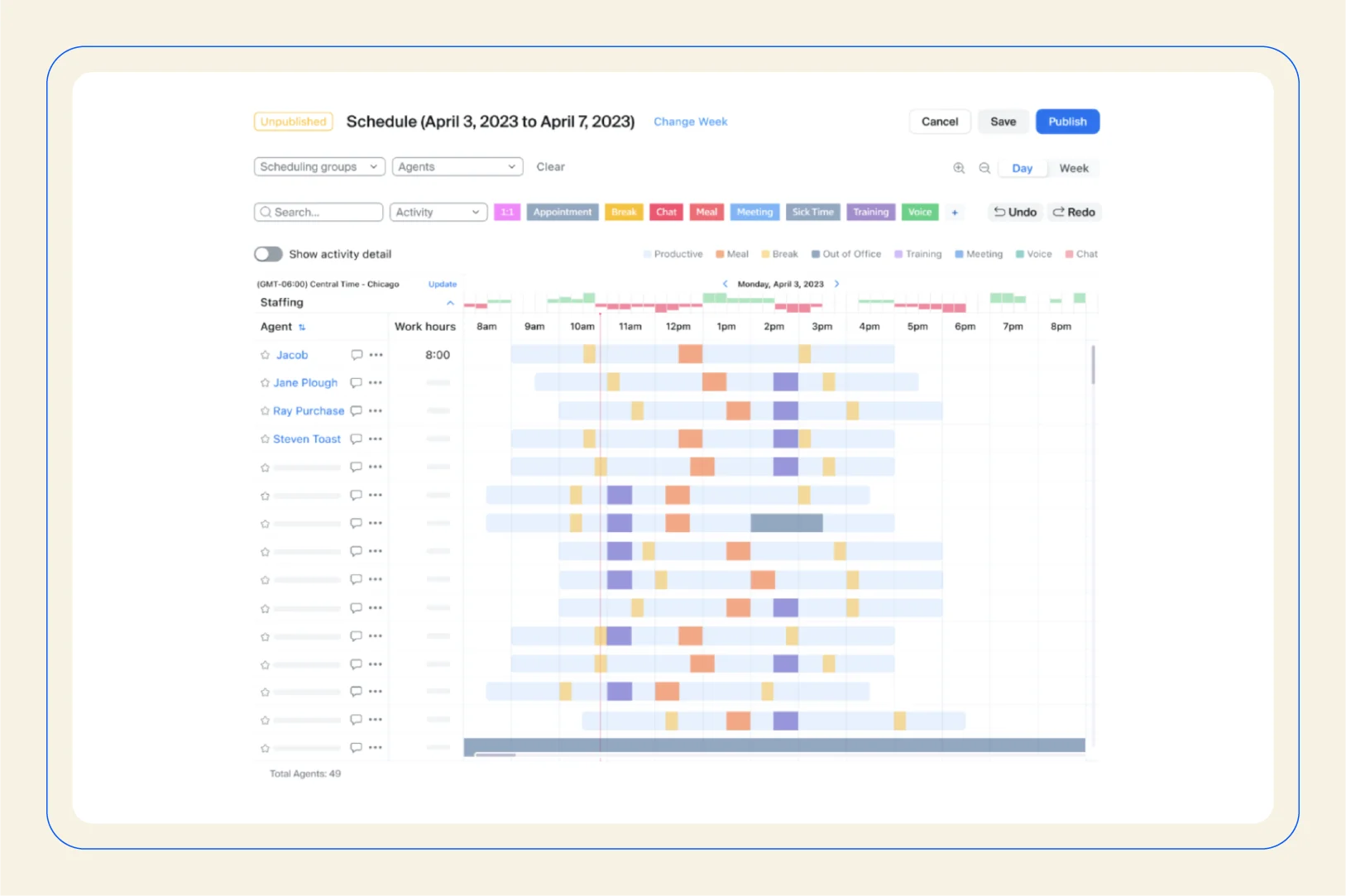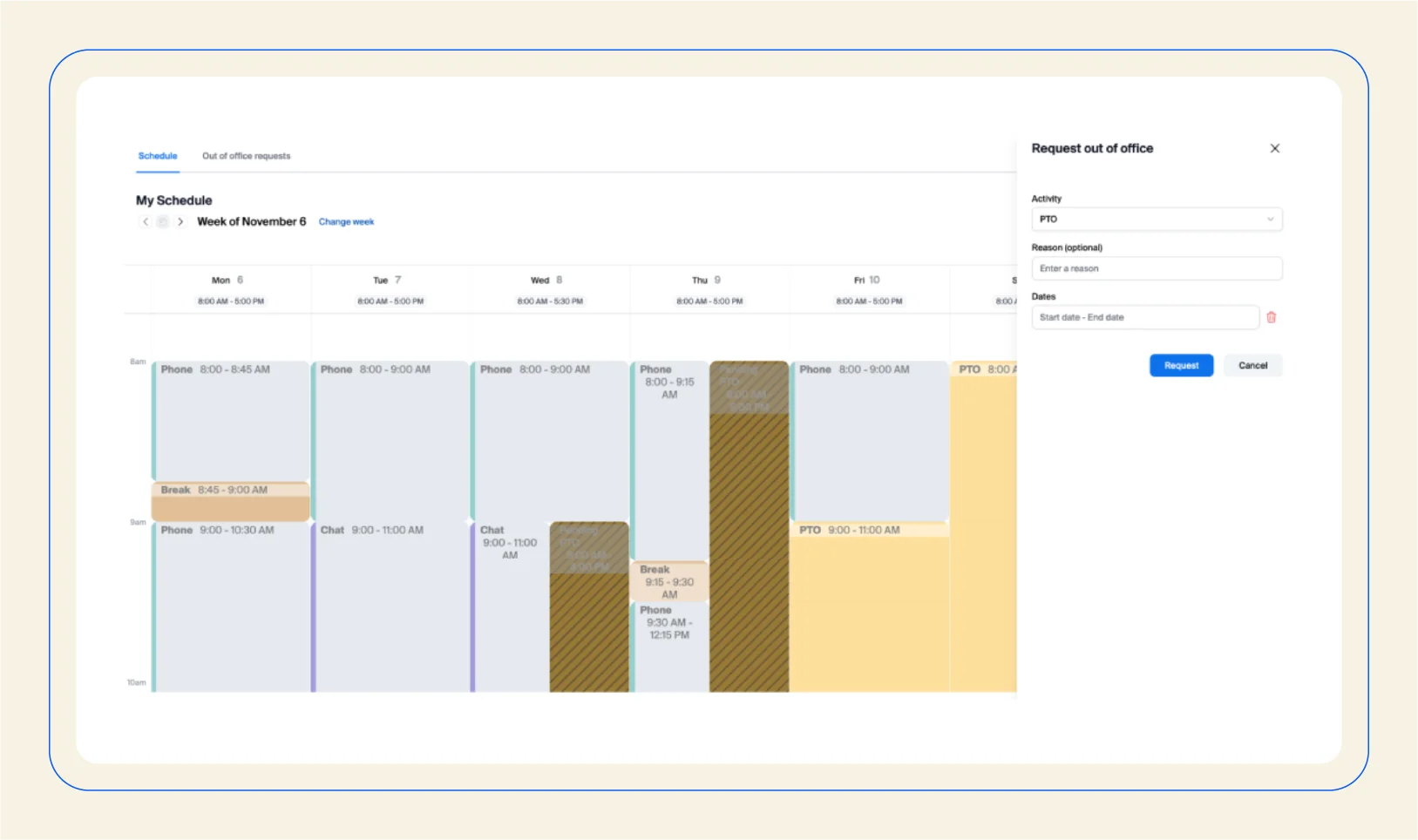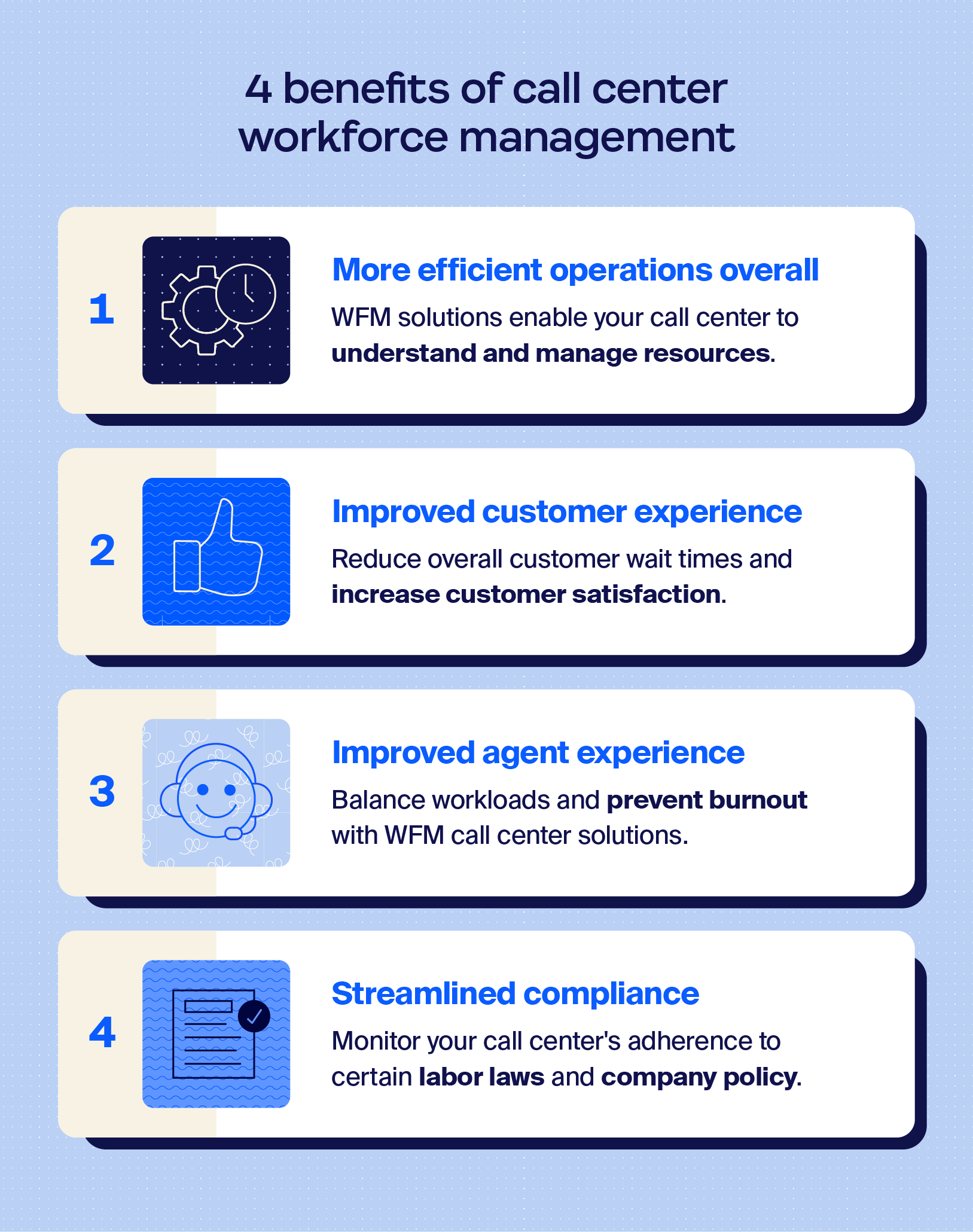
What is a cloud contact center and how to choose the best one
Explore what a cloud contact center is and how it's different from traditional contact center solutions. Explore features and tips to choose the right software.
Updated on September 11, 2024
Published on November 30, 2023


As a contact center supervisor, it can be challenging to determine the best ways to support customers while preventing agent burnout. Balancing service levels, overall performance, and efficiency is critical to an effective call center. Adapting a workforce management (WFM) call center approach is crucial for effective operation.
Challenges can be particularly intensive during peak times, but WFM call center solutions leverage the latest technology, including time-saving artificial intelligence, to help you manage more effectively. Discover why WFM solutions make a difference and tips for delivering first-class industry service.
WFM is a set of processes and contact center tools that help you optimize the performance and efficiency of your contact center team. The main goal of utilizing a WFM solution is to help confirm that the right number of agents with the right skills are available at the right times to meet customer service demands. The best contact center workforce management solutions include innovative AI-powered tools to help forecast, schedule, track, and analyze work performance.
But how can you make these innovations in workforce engagement work for you as you juggle increasing customer expectations and the potential of agent burnout? Lucky for you, we’ve pulled together some contact center workforce management best practices to help you sail through periods of heavier call volume now and as you plan ahead.
Workforce management can help transform ineffective routines into effective workflows. WFM processes can help your team provide high-quality service with data that enables capabilities such as call volume forecasting, which helps reduce wait times and deliver consistent service levels to callers.
Forecasting can also be an effective cost-saving method. Using analytics, your call center can properly align staff levels and prevent overstaffing. WFM solutions allow for custom reports and analytics that can provide a view of what you need and when – sometimes even before you need it.
WFM also benefits agents by allowing better workload balance and helping to free up additional time for training and development activities. With an improved scheduling perspective, you can also check that your agents are scheduled fairly and consistently, allowing for a better work-life balance and less burnout.
Your team should have the proper components when establishing a WFM call center. We’ll review four critical components to look for in a WFM solution.
A practical workforce management call center approach revolves heavily around effective scheduling for increased efficiency. This emphasis allows you to increase agent productivity and reduce burnout from excessive workloads through more data-driven decision-making.
WFM solutions help prevent over- or understaffing by creating call volume forecasts using historical data for better planning. Some tools offer automated scheduling features that consider agent preferences and skill sets, helping reduce manual effort and human error.
Enhanced time and attendance tracking enables a better understanding of agent log-ins, log-outs, and breaks. Having a real-time view of your call center operations lets you confirm your agents are where they need to be at the correct times. This understanding allows you to improve the overall experience for customers and agents, helping to ensure the latter receives proper break time.
Better insight into your time and attendance can also benefit overall efficiency, highlighting leave requests and attendance for future improvement. Such solutions even allow close tracking of compliance with company policies, allowing you to confirm work hours, breaks, and overtime all meet necessary guidelines.
Workforce management call center solutions can provide you and your team custom reports and analytics based on key performance indicators (KPIs). Call center KPIs that can be particularly important include the average handle time, time first to call resolution, and service level compliance. KPIs can give you deeper insights into your call center’s operation, leading to better data-driven decision-making.
Select WFM platforms also enable call center dashboard overviews and visualizations, which can enable you to understand data at a glance. You can view further trend analyses to identify trends in your work center’s performance, helping you to make more informed decisions about staff and ongoing processes.
The most critical aspect of any call center is its agents; they are your organization’s direct line of contact with your customer base. WFM approaches help check that your agents are versatile and engaged. Additional training can open up the world of customer empathy, allowing your agents to connect with frustrated individuals properly.
Using a WFM solution, you can focus your system on routing calls to the best available agent based on skill sets. Boosting your agent’s morale is just as important, and WFM solutions can simplify schedule management, time off requests, and swap shifts, causing less stress among your workforce.
For decades, workforce managers have had to manually create schedules. If they were lucky, they have some analytics and forecast tools with which to build them. Today, AI can take inputs from your contact center as well as dynamic agent schedules to create optimized schedules not only for the future, but also throughout the work day with intraday reports and analytics.
Give your agents more control over their schedules by offering shift bidding, the ability for agents to express interest in open shifts. This allows agents to pick up extra shifts and also helps you fill gaps in your schedules.
Integrating an effective workforce management strategy can seem daunting for call center leaders. These practical tips are the ideal way to begin your approach, leading later to further fine-tuning based on your call center’s unique operations.
Deploying agents at the right time is, of course, essential, but it’s also vital to confirm you have the right agent lined up. Matching an agent’s skills to the query helps avoid customer frustration and creates the necessary efficiencies as call volumes rise. As Juanita Coley, contact center whisperer and CEO of Solid Rock Consulting, shares:
“It’s about forecasting, scheduling, and real-time management. The power of workforce management comes down to predicting the right people, ensuring those people are in the right place, at the right time to best serve your customer needs.”
First, dive into historical data to make a plan. A good WFM tool can pull insights from your last peak season to predict the ideal schedule for your next busy period. Select solutions leverage AI and machine learning so you can pull data to predict call volume and call handling time. This capability helps you schedule up to four weeks out to analyze trends and determine your future needs quickly.

Second, make the most of your schedule to assign suitable agents to deal with specific customer calls. With WFM solutions, scheduling features allow you to optimize your roster by flexing breaks, lunches, and even start times based on your requirements. Your agents can achieve first-call resolution more effectively, and customers will appreciate getting their valuable time back.
Lastly, remember that things change, team members get sick, and bad weather can disrupt orders and cause an influx of calls. Even the best-laid plans can go out the window. Last-minute changes don’t need to be a headache with the right WFM software. When you can quickly pinpoint an agent’s capacity in real-time, adjusting the roster and reallocating calls becomes a walk in the park.
However, voice is just one channel to consider. With contact centers' increasing need for an omnichannel approach, contact center leaders need to look beyond voice when forecasting staffing needs. With a multi-channel forecasting model, Zoom Workforce Management removes the need for complex spreadsheets and heavy administrative work while adding the capability to monitor real-time adherence.
Burnout can severely impact agent morale, leading to staff absences or attrition. According to SQM Customer Service QA Experts, the average call center agent turnover was 38% in 2022, the highest rate they’ve seen. With customer care being your company’s front door, boosting connection and reducing turnover by even the smallest amount can make a difference. But how do you keep morale high during your busiest time of year?
Giving your contact center team predictability or control over their schedules is vital in helping them feel supported and empowered at busy times. Being aware and having access to schedules creates a mutually beneficial relationship between contact centers and their agents and can help improve retention. Coley found, “I recently surveyed agents, and schedule autonomy was the number two reason they like and stay in their job.”
How do you provide schedule autonomy without risking an empty call center? Get your agents involved in planning. Make sure you communicate your expectations and ask them for their availability and ideal work schedule in advance. Keep the lines of communication open, fostering a culture of trust and respect so they can approach you if anything changes at the last minute.

Give your team more flexibility by allowing them to work from home or a location that works best for them. Cloud contact centers, like Zoom Contact Center with AI Companion, have been designed to enable a dispersed team. And with workforce management built-in, you can stay on top of every agent’s performance.
Happy agents mean happy customers, so ensuring your agents feel engaged and empowered is crucial. Your agents are often your customers’ first touch point with your brand. With 65% of GenZ shoppers opting to leave a brand after one or two poor interactions, your agents are central to creating the customer loyalty and repeat business we’re all chasing for the latest generation of customers.
A significant way to invigorate your team during high-call volume periods is to give them all the resources and AI capabilities they need to do their jobs effectively and efficiently. Spot-check patterns and pull insights that can build a knowledge bank to help agents with future calls. As Adrian Swinscoe, Principal of Punk CX, puts it:
“Agents feel like they’re failing because they can’t solve a problem that was brought up before. Sharing information means the team can celebrate victory together.”
Tools like Zoom Contact Center’s AI Expert Assist can offer a helping hand here. By allowing you to curate and serve up useful knowledge-based articles and historical customer data, you can help agents quickly resolve issues for new and returning customers.
Showing appreciation for your agents’ work is a fantastic way to keep them engaged, connect with your staff, and create a more positive work environment. You don’t always need to go big — simple verbal recognition is a great way to make a call center agent feel valued. Tell them how positively their work affects the team in person or via email.
Consider offering rewards and incentives if you want to take appreciation to the next level. Monetary bonuses or gift cards are a great way to highlight agents who repeatedly go above and beyond in their roles, exceeding their target goals. Additional PTO can also serve as a valuable reward option.
To keep agents engaged and feeling appreciated more consistently, internal communications platforms like Workvivo by Zoom can help reinforce your company’s culture and foster a sense of belonging.
Contact center technology is undergoing an AI transformation, an evolution we call the next-generation contact center. But what can AI do to help with a contact center’s workforce needs during busy seasons?
Generative AI is a hot topic, poised to simplify the lives of contact center agents and supervisors significantly. Capabilities like chat and call summarization give individual agents more context to quickly and effectively handle transferred and returning calls and reduce call durations and customer frustration.
Then there’s our friend, the virtual agent. Virtual agents have been around for a while, but recent developments in AI are making them more intuitive and easier to build. Today, your IT team can create flows fast, and you can assign your virtual agent simple queries, freeing up your agents to solve the more complex, time-consuming questions.
Caleb Schleder, product support at Precision Planting, agreed when he spoke at Zoom’s recent user conference, Zoomtopia 2023: “Having the ability to use AI to optimize workforce engagement is so helpful.”
While workforce management solutions are necessary and helpful, there’s another way you can minimize siloed communication. As Metrigy found, by integrating your contact center capabilities with a unified communications platform, your team can benefit from:
Metrigy found in another research study earlier this year that integrating unified and contact center solutions resulted in a 26.5% improvement in customer ratings, an 18% reduction in operational costs, a 22.6% increase in revenue, and a 23.1% boost in employee efficiency (Metrigy, Transforming Customer Experience, January 2024). If you’re in the thick of an overwhelming peak season right now, exploring the possibility of a combined UC and CC solution might be something to consider so that you’re ready before it’s time to ramp up again.
Feedback is one of the most critical steps to a successful and engaged call center. Gaining feedback from your agents and customers provides valuable insights into your overall operation and consumer needs. Such insights are one of the keys to data-driven decision-making that propels your call center forward. Through feedback, you can learn:
To collect feedback, consider utilizing surveys and dedicated feedback collection tools. You can also obtain feedback data from your agents by asking directly during performance reviews or 1:1 meetings. Fostering an environment where agents and customers feel their feedback is valued is exceptionally vital to the process.
A properly implemented call center workforce management approach can have far-reaching benefits for your organization. From agents to customers, you can create a better experience backed by more efficient operations.

Call center workforce management helps create a more efficient operations workflow. WFM solutions enable your call center to understand and manage its resources better. Proper digital tools achieve this by collecting data, such as call volume, and providing data-driven forecasts that allow you to plan better. This process can also lead to cost savings, preventing such problems as routine over- or understaffing.
When your agents are directly in contact with your customer base, an improved customer experience is vital. By using WFM tools to align staff levels correctly, you can reduce overall customer wait times and increase customer satisfaction. WFM platforms can also check that customers receive consistent, high-quality service by pairing them with agents who have appropriate skill sets.
Your agents serve as your call center’s soul, so it’s important that they’re engaged and motivated. Balance workloads and prevent burnout with WFM call center solutions that monitor your operations. Further your agents’ skill and overall satisfaction by providing training and growth opportunities in the time slots that WFM solutions have cleared up due to increased efficiency.
You want to monitor your call center’s adherence to certain labor laws; this can quickly become a challenge with moving parts. WFM solutions can help monitor working hours, breaks, and overtime . Such solutions can also help you monitor compliance with company policy, allowing you to hold agents to the same practices as others — helping to create a level field.
Finding the delicate balance of answering a high volume of calls and queries while preventing team burnout takes work. Armed with the right technology and AI-enhanced tools and practices, you can eliminate the stress for all involved. Discover Zoom’s intuitive and easy-to-use workforce engagement management solution, the complete Zoom Contact Center, and its suite of next-generation tools.